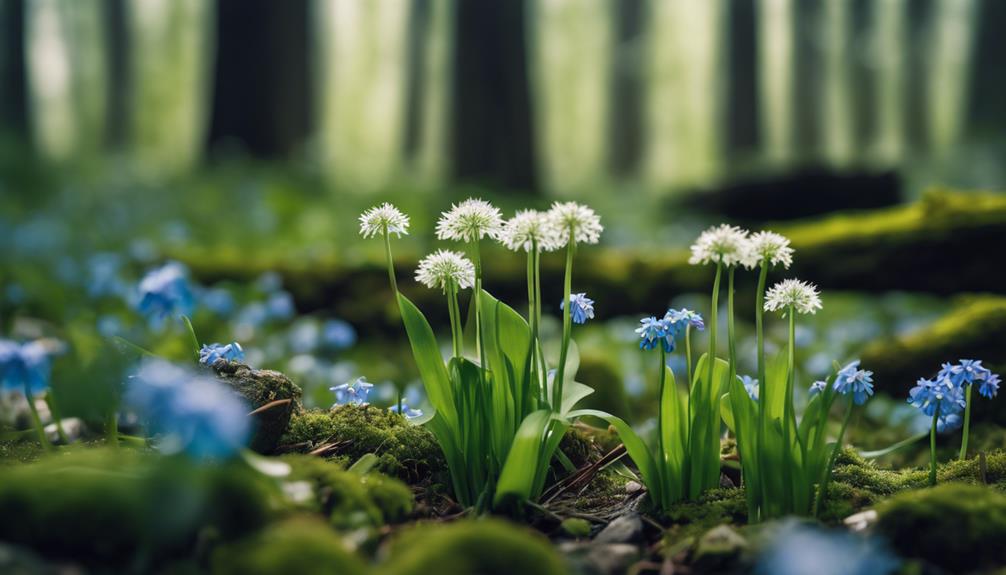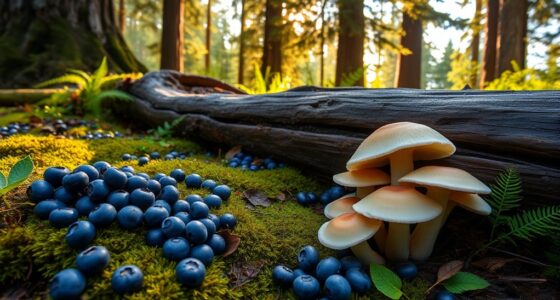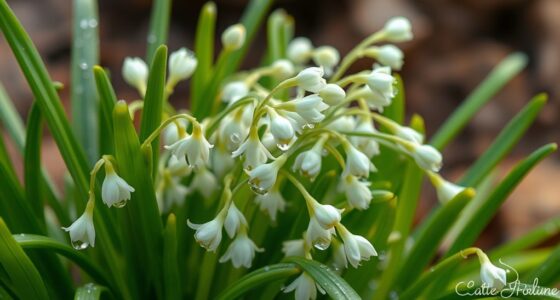As you venture into the world of spring foraging, you'll uncover over 20 varieties of fresh edibles waiting to be discovered. You'll find edible flowers like redbud, wild violets, and dandelion, as well as wild greens like chickweed, plantain, and stinging nettle. Medicinal plants like dandelion, chickweed, and wild violet are also ripe for the picking. Don't forget to forage for shoots and stems like cattail and wild asparagus, and fungi like morel and oyster mushrooms. With sustainable foraging practices, you can enjoy these nutrient-rich wild edibles while promoting a healthy ecosystem – and that's just the beginning of your foraging journey.
Key Takeaways
- In Spring, forage for edible flowers like redbud, wild violets, and dandelion, which add color and flavor to salads and dishes.
- Wild greens like dandelion, chickweed, and plantain are abundant in Spring and can be used in salads, sautés, and soups.
- Medicinal plants like dandelion, chickweed, and wild violet can be foraged in Spring to make teas, tinctures, and salves.
- Spring is the perfect time to forage for shoots and stems like cattail and wild asparagus, which can be grilled or sautéed as a side dish.
- Fungi and mushrooms like morel, oyster, and king bolete can be foraged in Spring, adding an earthy flavor to dishes and meals.
Spring's Edible Flowers
As you venture into the vibrant landscape of spring, you'll discover a colorful array of edible flowers waiting to be foraged, from the tender petals of redbud flowers to the delicate blooms of wild violets. These flowers are more than just a pretty face – they're also a gourmet food choice.
Dandelion flowers, for instance, can be used to make desserts, jellies, and even dandelion wine. Wild violets, which come in white and yellow varieties, offer edible flowers and leaves that can be used in a variety of dishes. Meanwhile, purple dead-nettles, part of the Mint family, can be used to make pesto.
As you forage for these edible flowers, keep an eye out for wild leeks, also known as ramps, a gourmet food choice that's perfect for spring. When foraging, remember to identify plants correctly for a safe and enjoyable culinary experience.
Wild Greens of the Season

You'll find that spring's vibrant landscape also yields a diverse array of wild greens, each bursting with nutrients and culinary potential.
As you venture into spring foraging, you'll discover an array of edible wild plants, including dandelion, chickweed, plantain, and common violets. These wild greens are rich in nutrients and can be used in teas, fritters, salads, and other culinary creations.
Foraging for wild greens connects you with nature and promotes sustainable food practices. However, identifying and harvesting wild greens accurately is essential for safe foraging in the spring season. Consulting local experts can help you learn about safe foraging practices and ensure a positive foraging experience.
Remember, accurate identification is key to avoiding misidentification and potential harm. By doing your research and exercising caution, you can enjoy the bounty of spring's wild greens, savoring their unique flavors and medicinal properties.
Medicinal Plants to Forage

Spring's medicinal bounty offers a diverse array of plants, each packed with healing properties waiting to be harnessed. As you venture out to forage, you'll discover an array of medicinal plants that can be used to create natural remedies for various ailments. From anti-inflammatory properties to antiseptic and antioxidant benefits, these plants are a treasure trove of health benefits.
| Medicinal Plant | Properties | Uses |
|---|---|---|
| Dandelion | Anti-inflammatory, antioxidant | Digestive issues, skin conditions |
| Chickweed | Antiseptic, anti-inflammatory | Skin irritations, minor wounds |
| Wild Violet | Antioxidant, anti-inflammatory | Respiratory issues, skin conditions |
| Willow | Pain relief, anti-inflammatory | Headaches, muscle pain |
Delicious Shoots and Stems

As you venture into the world of foraging in spring, you'll discover a treasure trove of tender shoots and crunchy stems waiting to be harvested. From cattail shoots that mimic the taste of cucumber to wild asparagus with its familiar flavor, these fresh edibles will add a unique twist to your meals.
Now, let's explore the tender tips and crunchy stems that spring has to offer.
Tender Tips Abound
Among the first signs of spring, tender shoots and stems burst forth, offering a symphony of flavors and textures that will elevate your culinary creations. As you venture out foraging for wild edibles, you'll discover a plethora of delicious and sustainable options. Early Spring brings an array of wild plants, each with its unique flavor profile and texture. When foraging, adopting sustainable practices is crucial to guarantee the long-term health of the plant and the ecosystem. By harvesting these tender tips, you'll not only enjoy the natural ingredients but also connect with the seasonal offerings of nature.
As you explore the world of foraging, you'll find that incorporating wild edibles into your diet introduces new tastes and textures to your meals. Delicate fiddleheads, crunchy asparagus, and pungent ramps are just a few examples of the treasures waiting to be discovered. When handling these early spring finds, remember to treat the plant with care, taking only what you need and leaving enough to secure the plant's continued growth. By doing so, you'll be able to savor the flavors of the season while preserving the natural balance.
Crunchy Stems Appear
While wandering through wetlands or wooded areas, you'll stumble upon an array of crunchy stems and shoots bursting with flavor and texture. As you forage in the spring, you'll discover an abundance of edible delights, each with its unique characteristics.
Cattail shoots, for instance, boast a mild flavor reminiscent of young corn, making them a versatile ingredient for various dishes. Ramps, with their vibrant green leaves and purple stems, pack a pungent punch, perfect for sautéing, grilling, or pickling. Fiddleheads, the coiled tops of ostrich ferns, offer a unique texture and taste when blanched, and can be enjoyed sautéed or pickled.
These crunchy stems and shoots aren't only delicious but also nutritious, providing a fresh and healthy addition to your spring menu. By harvesting these treats, you'll experience the thrill of foraging in the spring, when the earth awakens, and new life bursts forth.
Foraging for Fungi and Mushrooms

As you venture into the woods this spring, you'll have the opportunity to forage for a variety of delicious and prized fungi. From the prized morel mushrooms with their distinctive honeycombed caps to the delicate oyster mushrooms growing on dead trees, the possibilities are exciting.
But before you start foraging, it's crucial to learn about the types of spring mushrooms and adopt safe foraging practices to guarantee a fun and safe experience.
Types of Spring Mushrooms
You'll encounter a variety of prized spring mushrooms, each with unique characteristics that set them apart from others.
As you venture out for spring foraging, you'll have the opportunity to discover morel mushrooms, known for their distinct flavor and delicate texture.
Oyster mushrooms, with their mild and versatile taste, are also commonly foraged during this season.
If you're lucky, you might even stumble upon king bolete mushrooms, prized for their meaty texture and earthy flavor.
Spring is an exciting time for mushroom foraging, with a wide range of species available. However, it's important to remember that mushroom identification is vital to avoid toxic look-alikes and enjoy delicious finds.
With knowledge of safe identification practices, you'll be able to distinguish between different mushroom species and savor the fruits of your labor.
As you explore the world of spring mushrooms, keep in mind that accurate identification is key to a successful and safe foraging experience.
Safe Foraging Practices
Before you start foraging for fungi and mushrooms, make sure you're equipped with the knowledge and skills to do it safely. In the spring, it's especially important to be mindful of safe foraging practices to avoid mistakenly picking toxic look-alikes.
To guarantee a successful and safe foraging expedition, utilize field guides and expert guidance to accurately identify edible mushrooms and fungi. Take the time to learn about the unique characteristics, habitat preferences, and seasonal availability of different fungi and mushrooms. This knowledge will help you distinguish between safe and toxic varieties.
Practice sustainable harvesting methods to preserve mushroom populations and their natural habitats for future foraging opportunities. When handling wild mushrooms, take precautions such as cooking them thoroughly to eliminate any potential toxins or harmful compounds.
Edible Weeds in Your Backyard

Your backyard is likely home to a variety of edible weeds, including dandelions, chickweed, and wild violets, which are just waiting to be harvested and added to your meals. These wild edibles can add a burst of flavor and nutrition to your spring dishes.
Dandelion greens, for instance, make a delicious and highly nutritious salad green, with a slightly bitter taste. In late spring, you can also forage for garlic mustard, which adds a pungent, garlicky flavor to salads and sandwiches.
As you explore your backyard, keep an eye out for other spring wild edibles like clover, ramps, and cattail shoots. Stinging nettle, dead nettle, and henbit are also nutritious weeds that can be harvested in the spring.
Frequently Asked Questions
What Foods Can You Forage in the Spring?
You can forage for ramps, fiddleheads, morel mushrooms, chickweed, and dandelion greens in the spring, adding fresh flavors and nutrients to your meals while connecting with nature and promoting sustainability. Foraging wild foods in Scotland offers a wealth of diverse plant life, including seaweed, wild garlic, and sorrel, all of which have deep roots in traditional Scottish cuisine. Harvesting these ingredients not only enhances your culinary experiences, but also fosters a deeper understanding of local ecosystems and the seasonal rhythms of the land. Always remember to forage responsibly, ensuring you leave enough behind for wildlife to flourish. Foraging wild foods in Scotland is not only about acquiring ingredients but also about preserving traditions and supporting biodiversity. By learning to identify and sustainably harvest these natural treasures, you can contribute to the protection of native species and local habitats. Additionally, the act of foraging allows you to engage with the land in a more meaningful way, respecting the delicate balance between human needs and nature’s enduring bounty.
What Is in Season for Foraging?
As you venture out, you'll find that ramps, fiddleheads, and morels are in season, alongside wild greens like stinging nettle and chickweed, and edible flowers like redbud and wild violets.
How Do You Forage Wild Edibles?
You identify plants carefully, avoiding look-alikes, and harvest tender shoots, leaves, and flowers in their prime. You'll find the best spots by observing nature, researching, and joining foraging groups or guided tours to learn from experts.
What Is the Best Season for Forage?
You're wondering what the best season for foraging is, and honestly, it's spring! The mild weather and new growth make it ideal for finding fresh, flavorful, and nutritious wild edibles, allowing you to connect with nature and diversify your diet.
What Should You Avoid When Foraging?
Like a treasure hunter, you navigate the wild, but beware of pitfalls! When foraging, you should avoid areas with potential contamination, unknown plants, and over-harvesting, and always prioritize accurate identification to guarantee a safe and sustainable foraging experience.
Conclusion
As you venture out into the spring landscape, remember that the season's bounty is just beginning to unfurl. Wild edibles are waiting to be discovered, from vibrant flowers to tender shoots and medicinal wonders.
But the foraging journey doesn't end here – summer's warmth will bring new flavors and surprises. For now, savor the freshness of spring and get ready to uncover the secrets of the next season, just around the corner.










